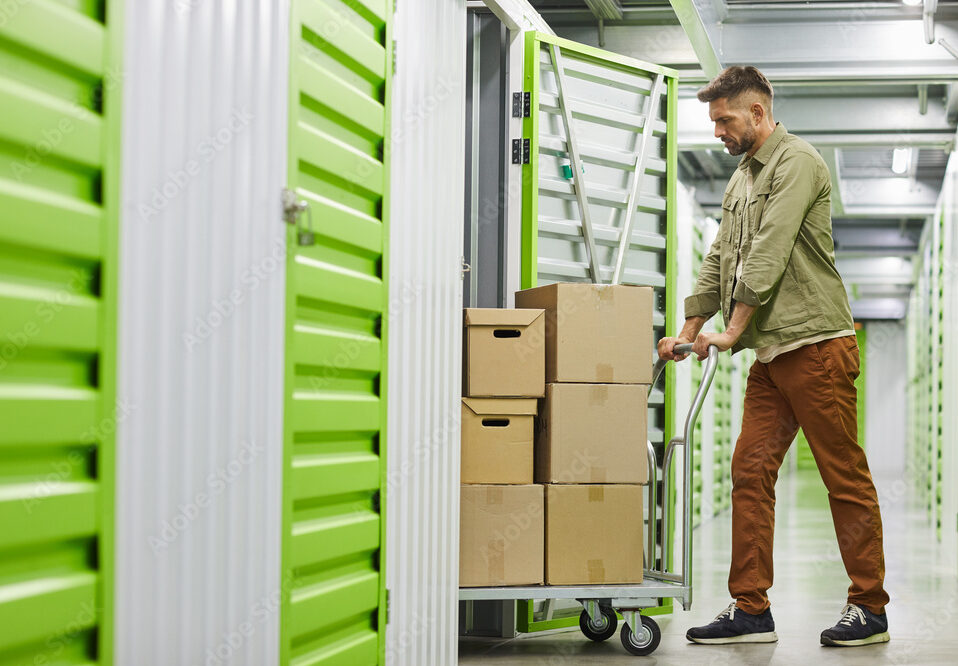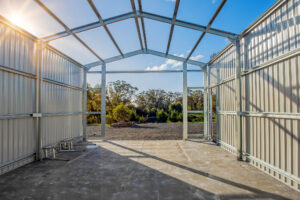Self-storage businesses have become increasingly popular in recent years, offering individuals and businesses a convenient solution for their storage needs. The business model of self storage is also pivotal to its success.
The US self-storage industry’s market is currently valued at $44.37 billion and is projected to reach $49.88 billion by 2029, growing at a compound annual growth rate (CAGR) of 2.37%.
Furthermore, an estimated 2.099 billion square feet of storage space is in operation, amounting to 6.32 square feet per person.
Before diving into the details of this venture, it is crucial to evaluate the profitability of such businesses.
In this article, we will explore the key components of the self-storage business model, factors that influence profitability, important financial metrics, and the risks and challenges that come with this industry.
Table of Contents
- Understanding the Self Storage–Business Model
- Factors Influencing Profitability in Self-Storage Businesses
- Financial Metrics for Evaluating Profitability
- Risks and Challenges in the Self-Storage Industry
- Conclusion
- Frequently Asked Questions
Understanding the Self Storage Business Model
Self-storage businesses operate on a simple premise—providing customers with space to store their belongings for a fee. The success of these businesses relies on efficiently managing the storage units and maximizing occupancy rates.
Let’s delve deeper into the key components of a self-storage business.
Self-storage businesses are not just about renting out space; they are about providing a secure and convenient solution for individuals and businesses looking to declutter or store their possessions.

These facilities often offer flexible rental terms, allowing customers to rent space for short or long periods based on their needs.
Additionally, some self-storage businesses provide climate-controlled units to protect sensitive items from extreme temperatures and humidity.
Check out: Your Guide To Mini Storage Buildings
Key Components of a Self-Storage Business
A self-storage business typically consists of the following components:
- Storage Units: These units serve as the core offering of the business and come in various sizes to accommodate different customer needs.
- Security Measures: Ensuring the safety of customers’ belongings is crucial. This includes implementing surveillance systems, access control measures, and adequate lighting.
- Customer Service: Providing excellent customer service can enhance customer satisfaction and drive repeat business. It involves effective communication, convenient payment options, and responsive staff.
Another essential component of a self-storage business is maintenance. Regular upkeep of the storage units, common areas, and security systems is vital to ensure a positive customer experience. Clean, well-maintained facilities not only attract customers but also help retain them in the long run.
Revenue Streams in Self-Storage Businesses
In addition to the rental income generated from storage units, self-storage businesses can diversify their revenue streams through value-added services such as selling packing supplies, offering insurance options, and providing vehicle storage.
These additional streams can contribute significantly to overall profitability.
Moreover, some self-storage businesses, depending on their model, partner with moving companies or offer in-house moving services to assist customers with transporting their items to and from the storage facility.
By providing a one-stop solution for storage and moving needs, these businesses can create a seamless experience for their customers and build loyalty in a competitive market.
Factors Influencing Profitability in Self-Storage Businesses
The profitability of a self-storage business is influenced by various factors. Let’s explore three key factors that significantly impact the bottom line.
Did You Know?
A typical storage facility business owner might expect to earn a yearly profit of around $184,500, based on an average annual rental rate of $9 per square foot for a facility size of 50,000 square feet, with a profit margin of approximately 41%.
Location and Market Demand
Choosing the right location is critical for success in the self-storage industry. Areas with high population density, limited competition, and a strong demand for storage solutions have the potential for higher occupancy rates and increased profitability.
Conducting thorough market research and analyzing demographic data can help identify lucrative locations.
Moreover, proximity to residential areas, commercial hubs, or university campuses can also play a crucial role in determining the success of a self-storage business.
Accessibility, visibility, and ease of reach are factors that can attract potential customers and drive up occupancy rates.
Understanding the local market dynamics and consumer behavior is essential in selecting a location that aligns with the target customer base.
Operational Costs and Overheads
Managing operational costs and overheads is essential to ensure profitability. These costs include property maintenance, staff wages, utilities, marketing expenses, and property taxes. Optimizing these expenses by implementing cost-saving measures and negotiating favorable contracts can ultimately impact the business’s profitability.
Furthermore, investing in technology and automation can streamline operations, reduce labor costs, and enhance overall efficiency. Implementing energy-efficient solutions, such as LED lighting and climate control systems, can also lead to long-term cost savings and contribute to a more sustainable business model.
By regularly reviewing and adjusting operational expenses, self-storage businesses can maintain a competitive edge in the market.
Pricing Strategies and Occupancy Rates
The pricing strategy employed by a self-storage business can significantly affect its profitability. Striking the right balance between competitive pricing and maximizing revenue per square footage is crucial. Additionally, maintaining high occupancy rates by implementing effective marketing strategies and offering attractive promotions can boost profitability.
Moreover, understanding customer segmentation and tailoring pricing plans to cater to different needs and budgets can help capture a wider market share. Offering flexible rental terms, discounts for long-term commitments, and value-added services can attract and retain customers, leading to improved occupancy rates and revenue generation.
Regularly monitoring market trends and competitor pricing strategies is essential in adjusting pricing models to stay competitive and sustain profitability in the self-storage industry.
Financial Metrics for Evaluating Profitability
When evaluating the profitability of a self-storage business, several financial metrics come into play. Let’s examine three key metrics commonly used in this industry.
Understanding the financial health of a self-storage business involves delving into various metrics that provide insights into its profitability and operational efficiency. Ü
By analyzing these metrics, stakeholders can make informed decisions to optimize performance and drive growth in the competitive self-storage market.
Net Operating Income (NOI)
Net Operating Income (NOI) is a fundamental indicator of a self-storage business’s profitability. It is calculated by subtracting operating expenses from gross rental income. A higher NOI indicates a more profitable operation.
NOI is a crucial metric for investors and operators as it reflects the revenue generated from core operations before considering taxes and financing costs.
By focusing on increasing NOI through revenue growth or cost reduction strategies, self-storage businesses can enhance their bottom line and attract potential investors seeking lucrative opportunities in the industry.
Return on Investment (ROI)
Return on Investment (ROI) measures the profitability of an investment relative to its cost. For self-storage businesses, ROI can be calculated by dividing the net profit generated by the initial investment. A higher ROI indicates a more lucrative investment.
ROI is a key metric for assessing the efficiency of capital deployment in self-storage ventures. Investors use ROI to evaluate the returns generated from their investments and compare them to alternative investment opportunities.
By monitoring and optimizing ROI, stakeholders can allocate resources effectively and maximize returns in a dynamic market environment.
Cash Flow Analysis
Examining the cash flow generated by a self-storage business is important to understand its financial health. Analyzing cash flow statements helps assess the ability to cover operating expenses, debt service, and fund future growth.
Cash flow analysis provides valuable insights into the liquidity and solvency of a self-storage business, indicating its ability to meet financial obligations and sustain operations in the long run.
By managing cash flow effectively, businesses can mitigate risks, seize growth opportunities, and maintain a competitive edge in the evolving self-storage landscape.
Risks and Challenges in the Self-Storage Industry
While self-storage businesses can be profitable, they also face several risks and challenges. Being aware of these challenges is crucial for making informed decisions.
Economic Downturns
One of the major risks that self-storage businesses face is the impact of economic downturns and market saturation. During times of economic hardship, individuals and businesses may downsize or cut costs, leading to decreased demand for storage units.
This can result in lower occupancy rates and ultimately impact the profitability of self-storage facilities. Additionally, market saturation can pose a challenge, as it leads to intense competition among self-storage providers.
With numerous options available, customers have the luxury of choosing the most affordable and convenient storage solution. To mitigate these risks, self-storage businesses must closely monitor market trends and adopt flexible strategies to adapt to changing customer needs and preferences.
Check out: Estimating Mini Storage Building Costs: A Financial Overview
Regulatory and Zoning Issues
Another challenge that self-storage businesses must navigate is regulatory and zoning issues. Complying with local regulations and zoning requirements is essential for the smooth operation of self-storage facilities.
Failure to comply can result in costly penalties or even closure of the facility. To avoid complications, self-storage businesses must engage legal professionals who specialize in the industry and stay updated on relevant regulations. This ensures that the business operates within the legal framework and avoids any unnecessary legal battles.
Check out: What Zoning Is Needed For RV Storage?
Technological Disruptions
Furthermore, technological disruptions and competition are becoming increasingly prevalent in the self-storage industry. The rise of innovative storage solutions, such as on-demand storage or valet storage services, poses a challenge to traditional self-storage businesses.
These new entrants leverage technology to offer more convenient and flexible storage options to customers.
To stay competitive, self-storage businesses must embrace technology and incorporate it into their operations. This can include implementing online booking platforms, adopting inventory management systems, or even exploring partnerships with technology-driven storage providers.
By leveraging technology, self-storage businesses can enhance customer experience and attract a wider customer base.
ALT IMG TXT: Self-storage facility with oversized doors.
Conclusion
As the self-storage industry continues to evolve, entrepreneurs must carefully assess the risks and challenges involved. Understanding the industry’s key components, factors influencing profitability, and important financial metrics is crucial for making informed decisions.
By evaluating these aspects and implementing effective strategies, entrepreneurs can maximize the profitability of their self-storage ventures.
Additionally, one must understand the self-storage business model, factors influencing profitability, financial metrics, and the risks and challenges of the self-storage industry.
SteelCo has over 23 years of experience dropshipping prefabricated self-storage and metal building materials nationwide. Our team has a combined experience of over 100 years in PEMB buildings.
We have a team of experts including Project Support Specialists, Sales Consultants, in-house Designers, Architects, and more, who are dedicated to providing the necessary guidance for starting up your self-storage business.
We work with suppliers who comply with industry standards such as the MBMA, AISC, and AISI, ensuring that you receive top-quality steel materials for your project. Learn more about our comprehensive services.
————————————————-
Frequently Asked Questions
Is it better to build a new storage facility or to buy an existing building?
Building a new self-storage facility offers complete control over design and features, allowing you to incorporate modern technology and create a fresh image. However, this option comes with higher upfront costs, a longer timeline, and the risk of cost overruns and a slow lease-up period.
On the other hand, buying an existing facility provides a faster entry into the market with an established customer base and income stream. It may require less initial investment, but you might face limitations in customization, the need for upgrades, potential maintenance issues, and a complex purchase process. Ultimately, the best choice depends on your budget, desired timeline, risk tolerance, and the level of control you want over the facility’s design and features.
What is the operational cost of a self storage business?
The average operating cost for storage units is about $3.78 per square foot. However, depending on factors such as salary costs in different markets, this can range from $2.75 to $3.25 per square foot.
What’s the start-up cost for a self storage business?
You’ll need to consider the land acquisition costs, which vary by location; construction and development expenses for materials, labor, and features; initial operating costs like utilities and staffing; legal and permit fees for compliance; marketing and advertising budget to attract customers; insurance policies for various risks; costs for equipment and technology such as security systems; and a contingency fund, typically 10-15% of total costs.
On average, starting a self-storage business can range between $1.25 million to $2.5 million, but this can fluctuate based on the scale and location of your operation. It’s crucial to perform a detailed financial analysis to ensure accurate budgeting for your business launch.
























